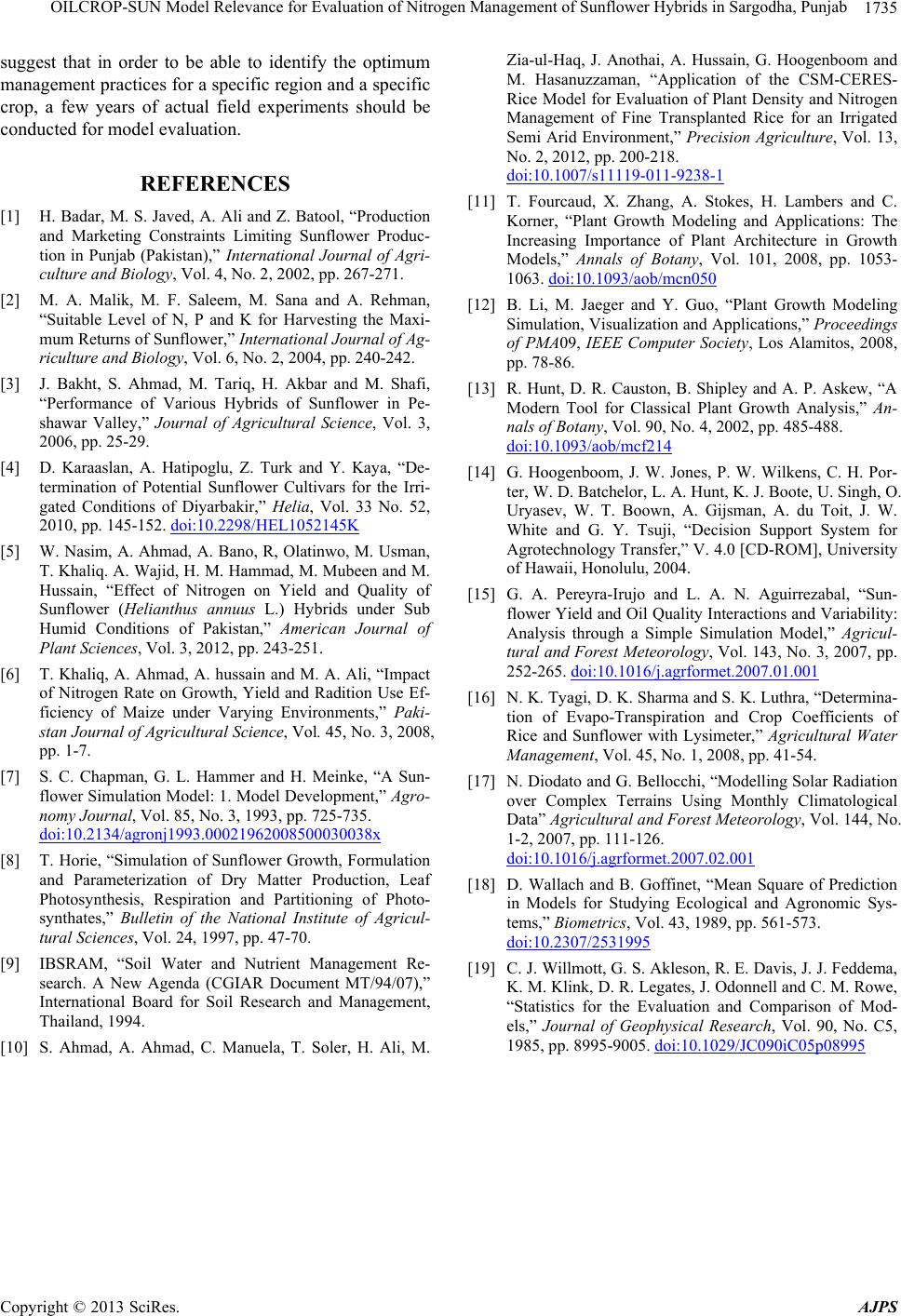
OILCROP-SUN Model Relevance for Evaluation of Nitrogen Management of Sunflower Hybrids in Sargodha, Punjab 1735
suggest that in order to be able to identify the optimum
management practices for a specific region and a specific
crop, a few years of actual field experiments should be
conducted for model evaluation.
REFERENCES
[1] H. Badar, M. S. Javed, A. Ali and Z. Batool, “Production
and Marketing Constraints Limiting Sunflower Produc-
tion in Punjab (Pakistan),” International Journal of Agri-
culture and Biology, Vol. 4, No. 2, 2002, pp. 267-271.
[2] M. A. Malik, M. F. Saleem, M. Sana and A. Rehman,
“Suitable Level of N, P and K for Harvesting the Maxi-
mum Returns of Sunflower,” International Journal of Ag-
riculture and Biology, Vol. 6, No. 2, 2004, pp. 240-242.
[3] J. Bakht, S. Ahmad, M. Tariq, H. Akbar and M. Shafi,
“Performance of Various Hybrids of Sunflower in Pe-
shawar Valley,” Journal of Agricultural Science, Vol. 3,
2006, pp. 25-29.
[4] D. Karaaslan, A. Hatipoglu, Z. Turk and Y. Kaya, “De-
termination of Potential Sunflower Cultivars for the Irri-
gated Conditions of Diyarbakir,” Helia, Vol. 33 No. 52,
2010, pp. 145-152. doi:10.2298/HEL1052145K
[5] W. Nasim, A. Ahmad, A. Bano, R, Olatinwo, M. Usman,
T. Khaliq. A. Wajid, H. M. Hammad, M. Mubeen and M.
Hussain, “Effect of Nitrogen on Yield and Quality of
Sunflower (Helianthus annuus L.) Hybrids under Sub
Humid Conditions of Pakistan,” American Journal of
Plant Sciences, Vol. 3, 2012, pp. 243-251.
[6] T. Khaliq, A. Ahmad, A. hussain and M. A. Ali, “Impact
of Nitrogen Rate on Growth, Yield and Radition Use Ef-
ficiency of Maize under Varying Environments,” Paki-
stan Journal of Agricultural Science, Vol. 45, No. 3, 2008,
pp. 1-7.
[7] S. C. Chapman, G. L. Hammer and H. Meinke, “A Sun-
flower Simulation Model: 1. Model Development,” Agro-
nomy Journal, Vol. 85, No. 3, 1993, pp. 725-735.
doi:10.2134/agronj1993.00021962008500030038x
[8] T. Horie, “Simulation of Sunflower Growth, Formulation
and Parameterization of Dry Matter Production, Leaf
Photosynthesis, Respiration and Partitioning of Photo-
synthates,” Bulletin of the National Institute of Agricul-
tural Sciences, Vol. 24, 1997, pp. 47-70.
[9] IBSRAM, “Soil Water and Nutrient Management Re-
search. A New Agenda (CGIAR Document MT/94/07),”
International Board for Soil Research and Management,
Thailand, 1994.
[10] S. Ahmad, A. Ahmad, C. Manuela, T. Soler, H. Ali, M.
Zia-ul-Haq, J. Anothai, A. Hussain, G. Hoogenboom and
M. Hasanuzzaman, “Application of the CSM-CERES-
Rice Model for Evaluation of Plant Density and Nitrogen
Management of Fine Transplanted Rice for an Irrigated
Semi Arid Environment,” Precision Agriculture, Vol. 13,
No. 2, 2012, pp. 200-218.
doi:10.1007/s11119-011-9238-1
[11] T. Fourcaud, X. Zhang, A. Stokes, H. Lambers and C.
Korner, “Plant Growth Modeling and Applications: The
Increasing Importance of Plant Architecture in Growth
Models,” Annals of Botany, Vol. 101, 2008, pp. 1053-
1063. doi:10.1093/aob/mcn050
[12] B. Li, M. Jaeger and Y. Guo, “Plant Growth Modeling
Simulation, Visualization and Applications,” Proceedings
of PMA09, IEEE Computer Society, Los Alamitos, 2008,
pp. 78-86.
[13] R. Hunt, D. R. Causton, B. Shipley and A. P. Askew, “A
Modern Tool for Classical Plant Growth Analysis,” An-
nals of Botany, Vol. 90, No. 4, 2002, pp. 485-488.
doi:10.1093/aob/mcf214
[14] G. Hoogenboom, J. W. Jones, P. W. Wilkens, C. H. Por-
ter, W. D. Batchelor, L. A. Hunt, K. J. Boote, U. Singh, O.
Uryasev, W. T. Boown, A. Gijsman, A. du Toit, J. W.
White and G. Y. Tsuji, “Decision Support System for
Agrotechnology Transfer,” V. 4.0 [CD-ROM], University
of Hawaii, Honolulu, 2004.
[15] G. A. Pereyra-Irujo and L. A. N. Aguirrezabal, “Sun-
flower Yield and Oil Quality Interactions and Variability:
Analysis through a Simple Simulation Model,” Agricul-
tural and Forest Meteorology, Vol. 143, No. 3, 2007, pp.
252-265. doi:10.1016/j.agrformet.2007.01.001
[16] N. K. Tyagi, D. K. Sharma and S. K. Luthra, “Determina-
tion of Evapo-Transpiration and Crop Coefficients of
Rice and Sunflower with Lysimeter,” Agricultural Water
Management, Vol. 45, No. 1, 2008, pp. 41-54.
[17] N. Diodato and G. Bellocchi, “Modelling Solar Radiation
over Complex Terrains Using Monthly Climatological
Data” Agricultural and Forest Meteorology, Vol. 144, No.
1-2, 2007, pp. 111-126.
doi:10.1016/j.agrformet.2007.02.001
[18] D. Wallach and B. Goffinet, “Mean Square of Prediction
in Models for Studying Ecological and Agronomic Sys-
tems,” Biometrics, Vol. 43, 1989, pp. 561-573.
doi:10.2307/2531995
[19] C. J. Willmott, G. S. Akleson, R. E. Davis, J. J. Feddema,
K. M. Klink, D. R. Legates, J. Odonnell and C. M. Rowe,
“Statistics for the Evaluation and Comparison of Mod-
els,” Journal of Geophysical Research, Vol. 90, No. C5,
1985, pp. 8995-9005. doi:10.1029/JC090iC05p08995
Copyright © 2013 SciRes. AJPS